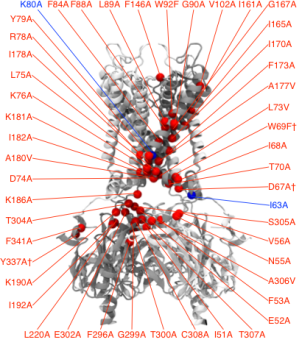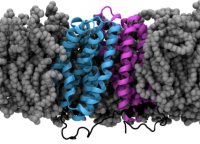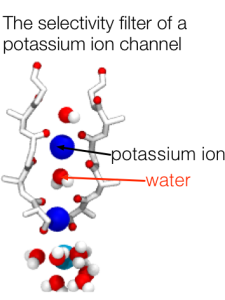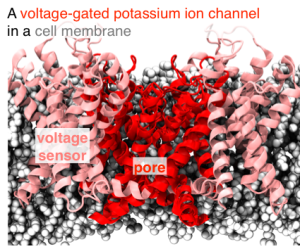In an earlier paper we showed that the closed state of Kir1.1, a important potassium ion channel found in the kidneys, was stabilised by a single hydrogen bond. This paper builds on that work by looking for any interactions that stabilise either the open or closed state of the channel by systematically mutating the majority of the residues to alanine. We were surprised to find that 47 mutations destabilised the open state but only 2 destabilised the closed state, one of which was the one we’d found before. Modelling suggests that this is because open conformations of the channel are more optimised and compact hence mutations tend to be more disruptive. The work was partly funded by the Wellcome Trust and hence the paper is free to download.
by looking for any interactions that stabilise either the open or closed state of the channel by systematically mutating the majority of the residues to alanine. We were surprised to find that 47 mutations destabilised the open state but only 2 destabilised the closed state, one of which was the one we’d found before. Modelling suggests that this is because open conformations of the channel are more optimised and compact hence mutations tend to be more disruptive. The work was partly funded by the Wellcome Trust and hence the paper is free to download.
Category Archives: research
So…. I’m a Software Sustainability Fellow
 I’m pleased to announce that I am one of the Software Sustainability Fellows for 2014. I met all the other fellows when we were being selected and it is an amazing group with very diverse research interests and backgrounds. This means I have a responsibility to try and improve the development and use of software in my field, computational biophysics. My plan is to
I’m pleased to announce that I am one of the Software Sustainability Fellows for 2014. I met all the other fellows when we were being selected and it is an amazing group with very diverse research interests and backgrounds. This means I have a responsibility to try and improve the development and use of software in my field, computational biophysics. My plan is to
- hold one or more Software Carpentry workshops. I organised the first Software Carpentry workshop at the University of Oxford in October 2012.
- learn about, and publicise the use of volunteer computing networks.
New Publication: Flexible Gates Generate Occluded Intermediates in the Transport Cycle of LacY

Inward-facing structure of the Lactose Permease (in blue and pink) embedded in a lipid bilayer (in grey)
In this paper we examine how the lactose permease, LacY, changes its structure to shuttle molecules of lactose across a cell membrane. The change in conformation is modelled usinga biased computational method called dynamic importance sampling (DIMS) and the results compared to the results of some previously published double electron electron spin resonance (DEER) experiments. We conclude that LacY, as expected, does pass through an occluded intermediate and this is incompatible a simple rigid-body motion as implied by a “rocker-switch” mechanism.
It is published in the Journal of Molecular Biology and is free to download (open access).
New Publication: Energetics of Multi-Ion Conduction Pathways in Potassium Ion Channels
Can we predict the conductance of a potassium ion channel from an experimental structure?
 In this paper we examine the kinetic barriers experienced by potassium ions (and waters) as they move through the narrowest part of two different potassium ion channels. We examine the reproducibility of our results and test the sensitivity of the approach to changes in the method. We conclude that we are currently unable to accurately calculate the kinetic barriers to conduction for potassium channels and that other channels (such as sodium channels) may be more amenable to this approach.
In this paper we examine the kinetic barriers experienced by potassium ions (and waters) as they move through the narrowest part of two different potassium ion channels. We examine the reproducibility of our results and test the sensitivity of the approach to changes in the method. We conclude that we are currently unable to accurately calculate the kinetic barriers to conduction for potassium channels and that other channels (such as sodium channels) may be more amenable to this approach.
This article is published in the Journal of Chemical Theory and Computation and is free to download (open access). It carries out the preparatory work necessary for a second paper on how potassium ions and water molecules move through the selectivity filter of a voltage-gated potassium ion channel.
New Publication: Detailed examination of a single conduction event in a potassium channel.
What can we learn using computational methods about how potassium ions and water molecules move through the narrowest part of a potassium channel?

In this paper, we calculate the average force experienced by three potassium ions as they move through the selectivity filter of a voltage-gated potassium channel. This allows us to identify the most probably mechanism, which includes two “knock-on” events, just like a Newton’s cradle. By examining the behaviour of the conducting waters and the protein in detail we can see how the waters rotate to coordinate one or other of the conducting potassium ions, and even get squeezed between two potassium ions during a knock-on event. We also see how the coordination number of each potassium ion changes.
This article is published in the Journal of Physical Chemistry Letters and is free to download (open access). There is an accompanying paper that is published in the Journal of Chemical Theory and Computation.
This blog…
…is where I shall put thoughts that at least might be of interest to other people. Any opinions are, I trust, my own and are not representative of my department or university in any way.